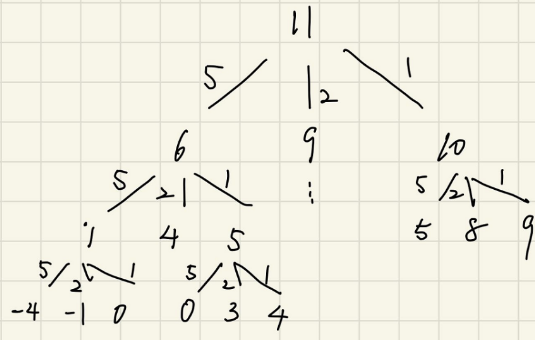硬币兑换
来源LeetCode, 题目地址<https://leetcode-cn.com/problems/coin-change/ >
给定不同面额的硬币 coins 和一个总金额 amount。编写一个函数来计算可以凑成总金额所需的最少的硬币个数。如果没有任何一种硬币组合能组成总金额,返回 -1。
暴力递归(回溯) 每一种硬币都有选择和不选两种情况,因此最简单的方法就是穷举所有可能性,从中找到最小的选择,递归树如下:
每次节点的子节点都会出现3个分支,因此时间复杂度是指数级。
尽管明知这个代码是不能通过LeetCode,我还是把代码给写完了。
1 2 3 4 5 6 7 8 9 10 11 12 13 14 15 16 17 18 19 20 21 class Solution1 {public : int MIN_COMB = INT_MAX; int coinChange (vector<int >& coins, int amount) DFS (0 , amount, coins); return MIN_COMB; } void DFS (int depth, int amount, vector<int >& coins) if (amount == 0 ){ MIN_COMB = min (depth, MIN_COMB); return ; } for (auto coin : coins){ if (amount - coin < 0 ) continue ; DFS (depth+1 , amount - coin, coins); } return ; } };
对于一些比较正常的数据,这个代码都能正常运行,但是对于LeetCode中的[186,419,83,408] 6249,标准答案是20,也就是至少有20层,因此计算量至少是3^20,但是递归深度可以达到75层,计算量就是一个天文数字了。
递归的广度优先搜索 递归树其实是一种深度优先的搜索方法,我们可以采用广度优先搜索方法,对递归树按层进行遍历,第一次遇到amount=0的时候,也就是最小的遍历层数。
1 2 3 4 5 6 7 8 9 10 11 12 13 14 15 16 17 18 19 20 21 22 23 24 class Solution2 {public : int coinChange (vector<int >& coins, int amount) queue<pair<int ,int >> q; q.push ({0 , amount}); while ( !q.empty ()) { int level = q.front ().first; int surplus = q.front ().second; q.pop (); for (auto c : coins){ if ( surplus - c < 0 ) continue ; if ( surplus - c == 0 ) return level + 1 ; q.push ({level+1 , surplus-c}); } } return -1 ; } };
尽管看起来, BFS或许比DFS能够更快的找到最终的解(不需要遍历所有的状态),但是由于递归树本身就是指数增长,因此只要层数过大,时间就会惊人的增长。
你可以保持[1,2,5]不变,然后依次测试,10,20,50,80,100. 你会发现前4个解决速度都比较快,但是到了100,时间就上天了。
贪心算法 暴力递归的问题在于,节点的增长是指数级别的。如果我们每次都选择当前的最优解,也就是对于11,从1,2,5中找交换的硬币的时候,都以5,2,1这种顺序进行选择,就避免了指数级别的增长。
1 2 3 4 5 6 7 8 9 10 11 12 13 14 15 16 17 18 class Solution {public : int coinChange (vector<int >& coins, int amount) sort (coins.begin (), coins.end (), std::greater<>()); return DFS (0 , amount, coins); } int DFS (int level, int amount, vector<int >& coins) if (amount <= 0 ){ return amount == 0 ? level : -1 ; } for (auto coin : coins){ int res = DFS (level+1 , amount - coin, coins); if (res > 0 ) return res; } return -1 ; } };
但是贪心算法有一个弊端,你得要证明能够从局部最优一直推导出全局最优解,才能保证你的结果是正确的。如果无法保证,那么贪心算法不一定保证最终结果就是最优解,所以这里贪心算法也是无法通过。
递归+记忆化 在我们之前的递归树中,无论采用何种遍历方式(DFS或BFS),都无法逃脱时间指数级别增长的命运。
不过当我们仔细观察递归树的时候,我们会发现一些节点是被重复计算的。如果能避免这些重复计算,那么时间复杂度就会降低到O(n^2)
在原来递归的代码上加上记忆化,我写了很久,主要是不知道在递归的时候,如何记录当前情况下,如何挑选最优子问题。
先放上正确的答案
1 2 3 4 5 6 7 8 9 10 11 12 13 14 15 16 17 18 19 20 21 22 23 class Solution {public : unordered_map<int , int > dict; int coinChange (vector<int >& coins, int amount) if (amount < 1 ) return 0 ; return DFS (coins, amount); } int DFS (vector<int >& coins, int amount) if (amount < 0 ) return -1 ; if (amount == 0 ) return 0 ; if (dict.find (amount) != dict.end ()) return dict[amount]; int min = INT_MAX; for (int coin : coins){ int res = DFS (coins, amount-coin); if (res >= 0 && res < min){ min = res + 1 ; } } dict[amount] = (min == INT_MAX ? -1 : min); return dict[amount]; } };
递归返回的从最后一层到当前层的所需的步数。而之前的递归程代码则是每次记录当前的深度,最终拿深度和全局最小值进行比较。
下面则是我的错误示范。我的代码主题也是想算出最后位置到当前位置的经历的步数,但是我想用最后一层的深度减去当前的深度。结果每一个amount对应都是1.
1 2 3 4 5 6 7 8 9 10 11 12 13 14 15 16 17 18 19 20 21 22 23 24 25 26 27 28 29 class Solution4 {public : unordered_map<int , int > dict; int coinChange (vector<int >& coins, int amount) return DFS (0 , amount, coins); } int DFS (int depth, int amount, vector<int >& coins) if (amount == 0 ){ return depth; } if (dict.find (amount) != dict.end () ) { return dict[amount]; } int local_min = INT_MAX; for (auto coin : coins){ if (amount - coin < 0 ) continue ; local_min = min (local_min, DFS (depth+1 , amount - coin, coins) -depth); } dict[amount] = (local_min == INT_MAX ? -1 : local_min); return dict[amount]; } };
自底向上的动态规划 事实上递归加记忆化就是一种动态规划,只不过递归是一种自顶向下的策略。并且有了之前递归加记忆化的经验,我们写递推就变得简单了。
第一步: 定义子问题。我们求解组成金额为n的最少硬币数,也就是求解一系列 n-k (k=coins) 子问题中的最小选择加1。以amount=11,coins=1,2,5为例。求解amount=11的最少硬币,也就是在10,9,6这三种选择中挑选其中所需硬币最小的子问题,然后加1.
第二步:定义DP数组. f(n) = min{f(n-k), k = 1,2,5} + 1
第三步: 定义DP方程: dp[i] = min(dp[i], dp[i-coins[j] ] )+ 1
最终代码如下
1 2 3 4 5 6 7 8 9 10 11 12 13 14 15 16 class Solution {public : int coinChange (vector<int >& coins, int amount) int MAX = amount + 1 ; vector<int > dp (amount+1 , MAX) ; dp[0 ] = 0 ; for (int i = 1 ; i <= amount; i++){ for (int j = 0 ; j < coins.size (); j++){ if (coins[j] <= i){ dp[i] = min (dp[i], dp[i-coins[j]] + 1 ); } } } return dp[amount] > amount ? -1 : dp[amount]; } };
代码中的细节,
初始化的数组大小为amount+1, 不能是amount, 否则只能表示0到amount-1
初始化的数组存放的值,要比最坏情况下的最少硬币数大,例如amount=10, 硬币只有11,那么数组内容就会是原本情况,最终的结果是比amount大,说明无解。因此,MAX = INT_MAX-1 也是可以的。
最终来看,自底向上的动态递归的代码反而是最简洁的。
